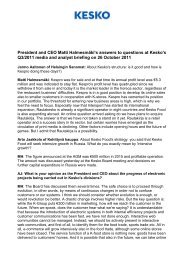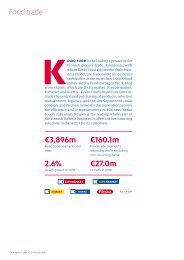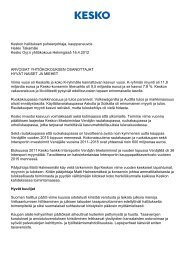You also want an ePaper? Increase the reach of your titles
YUMPU automatically turns print PDFs into web optimized ePapers that Google loves.
Year <strong>2007</strong><br />
Divisions The Group<br />
Financial<br />
statements<br />
Further information<br />
1) Financial assets at fair value through profit or loss<br />
All derivatives which do not qualify for hedge accounting in compliance<br />
with IAS 39 are classified as financial assets at fair value through profit<br />
or loss. Derivatives are carried at fair value using prices quoted in active<br />
markets. The results of derivatives hedging purchases and sales are recognised<br />
in other operating income or expenses. The results of derivatives<br />
used to hedge financial items are recognised in financial items, unless<br />
the derivative has been designated as a hedging instrument. The subcategory<br />
of financial assets at fair value through profit of loss in initial recognition<br />
includes investments in bond and special investment funds, as<br />
defined by the Group's treasury policy, as well as investments in other<br />
interest-bearing papers with over 3-month maturities. The interest<br />
income and fair value changes of these financial assets, as well as any<br />
commissions returned by funds are presented on a net basis in the<br />
income statement in the interest income of the category in question.<br />
2) Available-for-sale financial assets<br />
Available-for-sale financial assets are assets designated as available for<br />
sale at the date of initial recognition. Available-for-sale financial assets<br />
are measured at fair value at the balance sheet date and their fair value<br />
changes are recognised in equity. The fair value of publicly quoted financial<br />
assets is determined based on their market value. Financial assets<br />
not quoted publicly are measured at cost if their fair values cannot be<br />
measured reliably. The dividends from equity investments included in<br />
available-for-sale financial assets are recognised in financial items in the<br />
income statement. The interest income from available-for-sale financial<br />
assets is recognised in the financial items of the relevant category.<br />
3) Loans and receivables<br />
Loans and receivables are non-derivative assets with fixed or measurable<br />
payments. The Group's loans and receivables include trade receivables.<br />
They are recognised at amortised cost using the effective interest<br />
method.<br />
Cash and cash equivalents<br />
Cash and cash equivalents are carried at cost in the balance sheet. Cash<br />
and cash equivalents include cash on hand and balances with banks. The<br />
cash and cash equivalents in the consolidated balance sheet also include<br />
amounts relating to the retail operations of division parent companies,<br />
used as cash floats in stores, or amounts being transferred to the respective<br />
companies.<br />
Financial liabilities<br />
Financial liabilities have initially been recognised at fair value, net of<br />
transaction costs. In the financial statements, financial liabilities are<br />
measured at amortised cost using the effective interest rate method. The<br />
arrangement fees related to lines of credit are amortised over the validity<br />
period of the credit. Financial liabilities having a maturity period of over<br />
12 months after the balance sheet date are classified as non-current liabilities.<br />
Those having a maturity period of less than 12 months after the<br />
balance sheet date are classified as current liabilities.<br />
Derivative financial instruments and hedge accounting<br />
When acquired, derivative financial instruments are carried at fair value<br />
and subsequently measured at fair value at the balance sheet date. The<br />
changes in the fair value of derivatives that do not fulfil the hedge<br />
accounting requirements of IAS 39 are disclosed in the income state-<br />
87<br />
ment. The results of instruments hedging commercial currency risks are<br />
recognised in other operating income or expenses. The portion of derivatives<br />
hedging financial transactions to be recognised in the income statement<br />
is included in financial items.<br />
When entered into, derivative contracts are treated either as fair<br />
value hedges of receivables or liabilities, or in the case of currency risk,<br />
as cash flow hedges, as hedges of net investments in a foreign entity, or<br />
as derivative contracts that do not meet the hedge accounting criteria.<br />
When a hedging arrangement is entered into, the relationship<br />
between the item being hedged and the hedging instrument, as well as<br />
the objectives of the Group's risk management are documented. The<br />
effectiveness of the hedging relationship is tested regularly and the<br />
effective portion is recognised, against the change in the fair value of the<br />
hedged item, in translation differences in equity, or in the revaluation<br />
surplus. The ineffective portion is recognised in financial items or other<br />
operating income and expenses. The effective portion of the fair value<br />
change of instruments hedging cash flow, such as a long-term credit<br />
facility, is recognised in the equity hedging reserve. The value change of<br />
currency derivative instruments relating to the credit facility is recognised<br />
in the loan account, and the fair value changes of interest rate<br />
derivative instruments in other non-interest-bearing debt and<br />
receivables.<br />
Hedge accounting is discontinued when the hedging instrument<br />
expires or is sold, the contract is terminated or exercised. Any cumulative<br />
gain or loss existing in equity remains in equity until the forecast transaction<br />
has occurred.<br />
Measurement principles<br />
The fair value of forward rate agreements is determined by reference to<br />
the market price of the balance sheet date. The fair value of interest rate<br />
swaps is calculated on the basis of the present value of future cash flows<br />
using the market prices at the balance sheet date. The fair value of forward<br />
exchanges is determined by measuring the forward contracts at the<br />
forward rate of the balance sheet date. Currency options are measured by<br />
using the counterparty's price quotation, but the Group verifies the price<br />
with the help of the Black-Scholes method. Electricity and grain derivatives<br />
are measured at fair value using the market quotations of the balance<br />
sheet date.<br />
Hedging a net investment in a foreign entity<br />
The Group applies hedge accounting in accordance with IAS 39 to hedge<br />
foreign currency net investments in foreign units. Forward exchanges or<br />
foreign currency loans are used as hedging instruments. Spot price<br />
changes in forward exchanges are recognised as translation differences<br />
under equity, and changes in the interest rate difference are recognised<br />
as income under financial items. The exchange differences of foreign<br />
currency loans are stated as translation differences under equity. When a<br />
foreign entity is disposed of or wound up, the accumulated gains or<br />
losses from hedging instruments are recognised in profit or loss.<br />
Embedded derivatives<br />
The Group has prepared method descriptions to identify embedded derivatives<br />
and applies fair value measurement. Fair value is determined<br />
using the market prices of the measurement date and the value change is<br />
recognised in the income statement.















